C-19operational Magnocraft", briefly presented in chapter G of this monograph. One type ofevidence utilized in support of this proof was the uniqueness of the damage such vehiclesmust cause on Earth during an accidental explosion. For example the area of destructionformed by exploding UFOs should take the characteristic shape of a "butterfly" (see FigureC6), whose main axis must be parallel to a magnetic meridian. At the time of arriving toNew Zealand in 1982 the author knew about only one case of such an explosion, i.e.Tunguska in Central Siberia, where a cigar-shaped stack of three UFOs, type K6, explodedon 30 June 1908. Therefore, the legend concerning Raki-ura was of extreme interest tohim, as it could mean another site where similar spaceships have exploded existed also inNew Zealand. Immediately after hearing this legend the author initiated a search for thecentre of this explosion. However, this search brought first fruit in late 1987, when - with theactive help of his friends and acquaintances, the author finally managed to locate in NewZealand the position of a huge crater existing near the township of Tapanui.C2. The huge Tapanui CraterThe Tapanui Crater (see Figures A1, A2, and C1) is located in the West Part of theOtago Province of the South Island of New Zealand, within a triangle defined by the threefollowing towns: Tapanui, Waipahi, and Mataura. Its geographical co-ordinates are: 46 04'Sand 169 09'E. It lies entirely on private property. Its owner is Mr Rex Hellier (Pukeruau, R.D.1, Gore, New Zealand). The Tapanui Crater has the form of a rimless depression withhorizontal-bottom, embedded on a western slope of a small hill locally known as"Pukeruau". The slope of the hill where the Crater is located is slanted about 7 degrees,thus causing uneven heights on the Crater's eastern and western edges. The Crater isformed in clay and covered with silicone sand, so that its bottom does not reach the nativerock. Its size (i.e. length x width x depth) is about 900x600x130 metres. The outline of theTapanui Crater in aerial view roughly resembles an ellipsis - compare aerial photographsfrom Figure C1 with the Crater's outlines shown in Figure C2. But the part of the Craterwhere the shockwaves of the explosion entered the ground is shaped into a triangle withthe apical angle of around 100 degrees - see Figure C2. The main axis of the TapanuiCrater is declined at -37 degrees (westward) from the geographic north direction (thedeclination angle of -37 degrees probably results from the local course of the Earth'smagnetic field in Tapanui at the moment of explosion).Meteorite impacts or underground nuclear explosions provided data which developeda commonly prevailing opinion as to how a "typical" crater should appear. For the majorityof people such a crater must have a classical "parabolic-bowl" shape similar to thatdisplayed by the famous Diablo Crater in Arizona - see Figure C4. Unfortunately, thegeneral shape and main features of the Tapanui Crater differ significantly from thoseexpected for a "typical" crater. Furthermore, at first glance the visual appearance of theTapanui Crater caused by its on-slope location and reinforced by the washing out of a partof its western edge, is rather ambiguous, confusing, and non-distinct. The combination ofthese factors inclined people who have seen the Tapanui Crater to dismiss its significanceand to provide various non-explosive interpretations for its origin. This in turn has probablybeen the main reason why, in spite of overwhelming evidence available in its vicinity (andpresented in this publication), the Crater's explosive origin has remained unacknowledgedfor so long. However, readers familiar with cratering phenomena already know that apartfrom underground explosions producing craters considered to be "typical", there are alsotwo other types of explosions (illustrated in Figure C3) which produce craters of entirelydifferent shapes. Therefore, when thoroughly analyzed, the general shape of the TapanuiCrater is consistent with the near-ground version of an aerial explosion (unknown so-far innature and unobtainable in nuclear experiments) when it is applied to the configuration ofthe land above which the Tapanui explosion took place (this consistency is documented in
C-20item #2 that follows). Thus, in spite of a humble and ambiguous appearance, the TapanuiCrater is a meaningful reflection of the cataclysm which caused its formation.After a thorough analysis, the Tapanui Crater begins to reveal a number of attributes,all of which indicate its origin from a powerful magnetic explosion. Listed below are the mostessential of them.#1. The size of the Tapanui Crater is consistent with the energy yield of aroundseven UFOs type K6. The historic record prepared by Gervase of Canterbury anddescribed in subsection D1 allows to deduce that a cigar-shaped stack containing sevenUFOs type K6 most probably exploded over Tapanui. Because the author's calculationsprepared for the Magnocraft indicate that a single K6 type vehicle carries a magneticequivalent for around 10 megaton of TNT, Gervase's record suggests that in Tapanui theexplosion of seven K6 type UFOs should release an equivalent of around 70 megaton ofTNT (i.e. an equivalent to about 5600 atomic bombs of the size comparable to that ofHiroshima).This energy yield determined on the basis of a historic source can subsequently becompared to the yield resulting from the size of the Tapanui Crater. Tests of contemporarynuclear weapons provide various mathematical expressions which allow one to estimate theenergy yield of a given cratering explosion. For example, Figure 4 published on page 21 ofthe paper [1C2] by Henry F. Cooper, Jr., "A summary of explosion cratering phenomenarelevant to meteor impact events", (editors: Roddy D.J., Pepin R.O., Merrill R.B., "Impactand Explosion Cratering", Pergamon Press, New York, USA, 1977) shows that in order toremove 1 cubic meter of the ground through a near-ground aerial explosion, the energyyield of more than 1 ton of TNT is necessary. In the Tapanui Crater around 70 millions ofcubic metres of the ground were blasted out. Therefore it is easy to estimate that theenergy yield of this explosion was around the value of 70 megaton of TNT. This in turnindicates that the volume of the Tapanui Crater is consistent with Gervase's historic recordindicating the size of this explosion.Finally, there is a possibility of additional cross-checking the above consistency.Evidence indicates that UFOs which exploded in Tunguska were also type K6, i.e. exactlyof the same size as these from Tapanui (see the deductions in item #3 of subsection J1). Inthis Siberian explosion three such vehicles blasted - not seven as over Tapanui. On theother hand, experts estimate the power of Tunguska explosion at about 30 megaton of TNT(see the book [2C2] by Ronald D. Story {editor}: "The Encyclopedia of UFOs", New EnglishLibrary, London 1980, ISBN 0-450-04118-2, page 371). This means that each of theTunguska's K6 type of UFOs yielded about 10 megaton of magnetic energy, i.e. the exactamount produced by each K6 type UFO that exploded in Tapanui. Therefore, the power ofthe Tapanui explosion is also consistent with the power of the Tunguska explosion.To polemize with those people inclined to believe that it could be a heavenly body,not a UFO, exploding in Tapanui, it is worth highlighting that the yield of 70 megaton of TNTis too enormous to be created solely as the result of friction with the atmosphere - e.g. by aheavenly object passing by, but not hitting the ground. On the other hand, if a heavenlyobject would hit the ground in Tapanui, its fragments would still be there, and also theshape of the resultant crater would be different - as this will be explained in item #2 thatfollows.#2. The shape and features of the Tapanui Crater are consistent with the effects ofthe near-ground, aerial explosion. Contemporary experiments with nuclear weaponsprovided a great deal of information about cratering phenomena. This information enabledthe better understanding of the dynamic process involved in the formation of craters.According to recent findings, there are only three major types of cratering explosions. Theylead to the formation of drastically different craters - see Figure C3. These are theexplosions occurring: (a) underground, (b) on the surface of the ground, and (c) in the air.Because the medium which creates boundaries for the explosive charge (and thus which
- Page 1 and 2: Proof Copy ([5e/3] reformatted to P
- Page 3 and 4: 3G-83 G. Evidence certifying that M
- Page 5 and 6: 5Notes:(1) Before this monograph wa
- Page 7 and 8: A-2or disk"). The information which
- Page 9 and 10: A-4immune deficiency, thus it is qu
- Page 11 and 12: A-6edition, 1986) even tries to arg
- Page 13 and 14: A-8changes have no connection with
- Page 15 and 16: A-10Fig. A2. The curved slope in th
- Page 17 and 18: B-12inspired me to suspect that hum
- Page 19 and 20: B-14Earth by evil UFOnauts God trie
- Page 21 and 22: C-16#10. The spread, radiating from
- Page 23: C-18"Te Ura-a-Te Raki-Tamau", which
- Page 27 and 28: C-22comparative data which reflects
- Page 29 and 30: C-24exploding fires, columns of fir
- Page 31 and 32: C-26banks of the Black Gully Creek,
- Page 33 and 34: C-28meditating, conducting healing
- Page 35 and 36: C-30deaths of people with symptoms
- Page 37 and 38: C-32(1) The Kawakawa volcano erupte
- Page 39 and 40: C-34The Tapanui Crater is the centr
- Page 41 and 42: C-36Fig. C2. The inner topography o
- Page 43 and 44: C-38(a)(d)(b)(c)(e)Fig. C4. Example
- Page 45 and 46: C-40Fig. C6. The illustration of si
- Page 47 and 48: C-42Fig. C8. The distribution of in
- Page 49 and 50: C-44Fig. C10. Two photographs of a
- Page 51 and 52: C-46Fig. C12. The location of near-
- Page 53 and 54: C-48Fig. C14. A magnetized metallic
- Page 55 and 56: D-50Chapter D:EVIDENCE THAT THE TAP
- Page 57 and 58: D-52including Mediterranean and Biz
- Page 59 and 60: D-54rapidly released by this explos
- Page 61 and 62: D-56experiments, and many more. Thi
- Page 63 and 64: D-58that people were in medieval ti
- Page 65 and 66: D-60then continually resonates in t
- Page 67 and 68: D-62"tapanui.htm") are to be met, s
- Page 69 and 70: D-64when such abnormalities of the
- Page 71 and 72: E-66Chapter E.HYPOTHESES EXPLAINING
- Page 73 and 74: E-68is directed towards the magneti
- Page 75 and 76:
F-70publication of this design and
- Page 77 and 78:
F-72can be built, each type taking
- Page 79 and 80:
F-74sites an explosive growth of mu
- Page 81 and 82:
F-76F4. Explosion sites of the Magn
- Page 83 and 84:
F-78- Deficiency of some sensitive
- Page 85 and 86:
F-80(a)…(b)…(c)Fig. F2. The des
- Page 87 and 88:
F-82Fig. F4. The explanation for a
- Page 89 and 90:
G-84The formal proof that "UFOs are
- Page 91 and 92:
G-86civilization(s) sending UFOs mu
- Page 93 and 94:
G-88the close proximity of the Tapa
- Page 95 and 96:
G-90(c)(d)Fig. G1. Two photographs
- Page 97 and 98:
G-92(a)(c)(b)(d)(e)Fig. G3. A spher
- Page 99 and 100:
G-94(a)(b)(c)(d)Fig. G5. Pulsating
- Page 101 and 102:
G-96(a)(b)(c)(d)(e)Fig. G7. Smooth,
- Page 103 and 104:
G-98(a)(b)(c)(d)Fig. G9. Photograph
- Page 105 and 106:
H-100#6. The Tapanui Crater is orie
- Page 107 and 108:
I-102Chapter I:MORAL ACCENTUATION O
- Page 109 and 110:
J-104explosion energy carrier would
- Page 111 and 112:
J-106detonation a number of appropr
- Page 113 and 114:
J-108resembled "china stones" from
- Page 115 and 116:
K-110Chapter K:AROUND 13 500 YEARS-
- Page 117 and 118:
K-112civilisation were prepared for
- Page 119 and 120:
L-114Chapter L:STILL ANOTHER UFO EX
- Page 121 and 122:
L-116Coincidentally, the author had
- Page 123 and 124:
M-118in section D3). This in turn h
- Page 125 and 126:
N-120Chapter N:TWELVE TRUTHS ABOUT
- Page 127 and 128:
N-122only factors which may cause t
- Page 129 and 130:
N-124ones who stand by truth and th
- Page 131 and 132:
O-126Chapter O:ACADEMIC ASPECTS OF
- Page 133 and 134:
O-128Galactic field, thus producing
- Page 135 and 136:
O-130specifically what was wrong wi
- Page 137 and 138:
O-132moral field causes that we acc
- Page 139 and 140:
O-134white glowing balls of playful
- Page 141 and 142:
O-136brought disgrace to that unive
- Page 143 and 144:
O-138the Polish language only, whic
- Page 145 and 146:
O-140occupation of Earth, and then
- Page 147 and 148:
O-142in a few years of time, when t
- Page 149 and 150:
O-144and both these matters were se
- Page 151 and 152:
O-146today. We need to realize this
- Page 153 and 154:
O-148Of course, the above history i
- Page 155 and 156:
O-150two kinds of resource publicat
- Page 157 and 158:
R-152Chapter R:AT THE END OF THIS M
- Page 159 and 160:
R-154forget that such paid scientis
- Page 161 and 162:
S-156Chapter S:REFERENCES COMPLEMEN
- Page 163 and 164:
S-158[7/2] Giordano D. and Pajak J.
- Page 165 and 166:
T-160Magnocraft exploded over New Z
- Page 167 and 168:
Z-162Appendix Z:Directions for gett
- Page 169:
Z-164Fig. Z1. The most educational



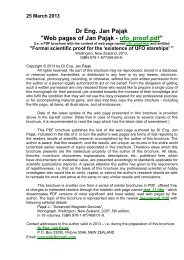



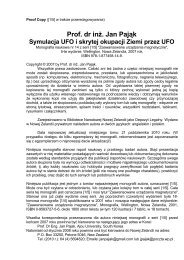


![[1/4p]: PDF - Totalizm](https://img.yumpu.com/45003232/1/184x260/1-4p-pdf-totalizm.jpg?quality=85)

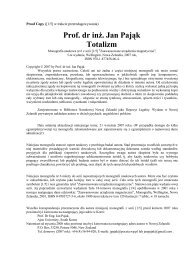
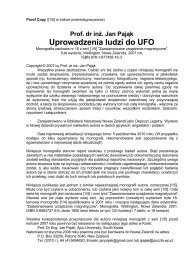
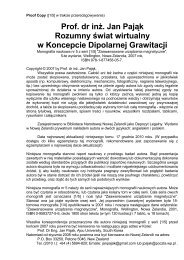
![[1/4p]: PDF - Totalizm](https://img.yumpu.com/39351336/1/184x260/1-4p-pdf-totalizm.jpg?quality=85)
